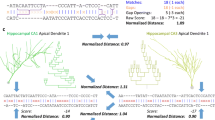Abstract
The geometrical properties of neurons are important for the way they function within neural circuits. The arborescent processes of neurons that are necessary for the transmission of the information are formed by branching and elongation of segments. In studies that model the outgrowth the tree structures have generally been considered as binary. However, multifurcations do occur. It will be shown that if the multifurcations can be considered as aggregates of bifurcations they may be included in the topological analysis of neuronal branching patterns.
Similar content being viewed by others
Literature
Berry, M. and R. Flinn. 1984. Vertex analysis of Purkinje cell dendritic trees in the cerebellum of the rat.Proc. R. Soc. Lond. B221, 321–348.
Berry, M., T. Hollingworth, E. M. Anderson and R. M. Flinn. 1975. Application of network analysis to the study of the branching patterns of dendritic fields. In:Advances in Neurology, Vol. 12, G. W. Kreutzberg (Ed.), pp. 217–245. New York: Raven Press.
Berry, M., P. McConnell and J. Sievers. 1981. Dendritic growth and the control of neuronal form. In:Current Topics in Developmental Biology, Vol. 15, R. Hunt (Ed.), p. 67–101. New York: Academic Press.
Berry, M., M. Sadler and R. Flinn. 1986. Vertex analysis of neural tree structures containing trichotomous nodes.J. Neurosci. Meth. 18, 167–178.
Biggs, N. L. 1985.Discrete Mathematics, Oxford University Press.
Bray, D. 1973. Branching patterns of individual sympathetic neurons in culture.J. Cell Biol. 56, 702–712.
Bray, D. and M. B. Bunge. 1973. The growth cone in neurite extension. In:Locomotion of Tissue Cells. Ciba Foundation Symposium 14 (new series), pp. 195–209, Amsterdam: Elsevier.
Calvet, M. J. and J. Calvet. 1984. Computer assisted analysis of HRP labelled and Golgi stained Purkinje neurons.Progr. Neurobiol. 23, 251–272.
Coates, P. W. 1986. Quantitation and morphological characterization of rapid axon and dendritic growth from single cerebral hemispheric neurons in hydrated collagen lattice culture.Dev. Brain Res. 25, 11–20.
Cohan, C. S. and S. B. Kater. 1986. Suppression of neurite elongation and growth cone motility by electrical activity.Science 232, 1638–1640.
Comtet, L. 1974.Advanced Combinatorics. Dordrecht: Reidel.
Conover, W. L. 1980.Practical Nonparametric Statistics (Second edn.). New York: Wiley.
Eysel, U. T., L. Peichl and H. Wässle. 1985. Dendritic plasticity in the early postnatal feline retina: quantitative characteristics and sensitive period.J. Comp. Neurol. 242, 134–145.
Glaser, E. M., H. Van der Loos and M. Gisler. 1979. Tangential orientation and spatial order in dendrites of cat auditory cortex: a computer microscope study of Golgi-impregnated material.Exp. Brain Res. 36, 411–431.
Harding, E. F. 1971. The probabilities of rooted tree-shapes generated by random bifurcation.Adv. Appl. Prob. 3, 44–77.
Hollingworth, T. and M. Berry. 1975. Network analysis of dendritic fields of pyramidal cells in neocortex and Purkinje cells in the cerebellum of the rat.Phil. Trans. R. Soc. Lond. B270, 227–264.
Horsfield, K., M. J. Woldenberg and C. L. Bowes. 1987. Sequential and synchronous growth models related to vertex analysis and branching ratios.Bull. math. Biol. 49, 413–429.
Kliemann, W. 1987. A stochastic dynamical model for the characterization of the geometrical structure of dendritic processes.Bull. math. Biol. 49, 135–152.
Percheron, G. 1979. Quantitative analysis of dendritic branching. I. Simple formulae for the quantitative analysis of dendritic branching.Neurosci. Lett. 14, 287–293.
Purves, D. and J. W. Lichtman. 1985.Principles of Neural Development. Sunderland: Sinauer.
Sadler, M. and M. Berry. 1983. Morphometric study of the development of Purkinje cell dendritic fields of the mouse using vertex analysis.J. Microsc. 131, 341–354.
Smit, G. J., H. B. M. Uylings and L. Veldmaat-Wansink. 1972. The branching pattern in dendrites of cortical neurons.Acta Morphol. Neerl.-Scand. 9, 253–274.
Speidel, C. C. 1942. Studies of living nerves. VII. Growth adjustments of cutaneous terminal arborizations.J. Comp. Neurol. 76, 57–73.
Speidel, C. C. 1964.In vivo studies of myelinated nerve fibers.Int. Rev. Cytol. 16, 173–231.
Stuermer, C. A. O. 1984. Rules for retinotectal terminal arborizations in the goldfish optic tectum.J. Comp. Neurol. 229, 214–232.
Todd, J. A. 1944. A table of partitions.Proc. Lond. math. Soc. 48, 229–241.
Van Pelt, J. and R. W. H. Verwer. 1983. The exact probabilities of branching patterns under terminal and segmental growth hypotheses.Bull. math. Biol. 45, 269–285.
Van Pelt, J. and R. W. H. Verwer. 1985. Growth models (including terminal and segmental branching) for topological binary trees.Bull. math. biol. 47, 323–336.
Van Pelt, J. and R. W. H. Verwer. 1986. Topological properties of binary trees grown with order-dependent branching probabilities.Bull. math. Biol. 48, 197–211.
Van Pelt, J., R. W. H. Verwer and H. B. M. Uylings. 1986. Application of growth models to the topological structure of neuronal branching patterns.J. Neurosci. Meth. 18, 153–165.
Verwer, R. W. H. and J. Van Pelt. 1983. A new method for the topological analysis of neuronal tree structures.J. Neurosci. Meth. 8, 335–351.
Verwer, R. W. H. and J. Van Pelt. 1985. Topological analysis of binary tree structures when occasional multifurcations occur.Bull. math. biol. 47, 305–316.
Verwer, R. W. H. and J. Van Pelt. 1986. Descriptive and comparative analysis of geometrical properties of neuronal tree structures.J. Neurosci. Meth. 18, 179–206.
Verwer, R. W. H. and J. Van Pelt. 1987. Multifurcations in topological trees: growth models and comparative analysis.Acta Stereol. 6/III, 399–404.
Verwer, R. W. H., J. Van Pelt and A. J. Noest. 1987. Estimation of parameters in topological growth models for neuronal trees.Bull. math. Biol. 49, 363–378.
Verwer, R. W. H., J. Van Pelt and H. B. M. Uylings. 1985. A simple statistical test for the vertex ratio using Monte Carlo simulation.J. Neurosci. Meth. 14, 137–142.
Woodward, D. J., A. Seiger, L. Olson and B. J. Hoffer. 1977. Intrinsic and extrinsic determinants of dendritic development as revealed by Golgi studies of cerebellar and hippocampal transplantsin oculo.Exp. Neurol. 57, 984–998.
Author information
Authors and Affiliations
Rights and permissions
About this article
Cite this article
Verwer, R.W.H., Van Pelt, J. Analysis of binary trees when occasional multifurcations can be considered as aggregates of bifurcations. Bltn Mathcal Biology 52, 629–641 (1990). https://doi.org/10.1007/BF02462102
Received:
Issue Date:
DOI: https://doi.org/10.1007/BF02462102




